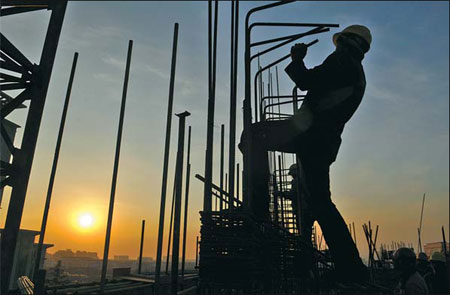Subway expansion enables flight to the cheaper suburbs
Updated: 2011-12-21 08:04
By Wang Ying (China Daily)
|
|||||||||
|
New residential buildings keep going up. This construction site is in Rizhao, Shandong province. [Chen Weifeng / for China Daily] |
SHANGHAI - In the university town of Songjiang, about an hour's drive from downtown Shanghai, a real estate developer is making a big push to lure buyers to a project romantically named Milano Palace.
Shanghai Milan Property Development Co has hired a bus to ferry young couples to the site. As they alight, these prospective buyers are greeted by a horde of salespeople from various agencies waving brochures at their prey.
The main attraction of this project, said Wang Chenyun, a sales agent for Shanghai Deovolente Realty Co, is that all the apartments are the same size, about 90 square meters, which is "ideal for newly married couples".
The average price of an apartment there, around 1.17 million ($184,500), seems right for those buyers, too. To sweeten the deal, Wang said, "We are offering everyone who signs up today a fat discount."
Coco Yang of Milan Property said nearly half of the young couples who saw the apartments that November day made the plunge on the spot to take advantage of the 10 to 15 percent discount.
"I am really tempted," said Chen Weiming, 27, a white-collar worker at a foreign company in Shanghai, while his girlfriend nodded by his side. But, he said, "I want to see some more apartments in other suburbs before making up my mind."
A new way of life
Many young couples in Shanghai are looking for their dream homes farther and farther away in the suburbs. Just a few years ago, both developers and homebuyers in Shanghai largely ignored Songjiang and many other suburbs. That is changing, fast.
This year, hundreds of newly completed apartments in two projects, including Milan Palace, were put up for sale and many more are coming onstream. The trend of moving to the suburbs, especially among young Shanghai couples, is propelled by escalating property prices in inner-city districts and expansion of the subway system.
While Shanghai constructs one of the longest metro networks in the world, the living space of local people and new immigrants is undergoing a profound transformation. Dwelling in the suburbs and working downtown is a new way of life in this economic hub.
Metro boom
In 2005, the city had only three metro lines. By 2008, eight lines were operating. The metro boom was fueled by the successful bid for the Shanghai World Expo, and when it opened on May 1, 2010, a dozen lines were running over a network 420 km long.
By 2020, Shanghai will manage 20 lines with a length of 960 km, a new achievement for the city that flourished in the 1920s and '30s and was dubbed the top economic hub of the Far East.
Along with their stated goal of developing Shanghai's suburbs and satellite cities, city planners are eyeing a more efficient transportation system in the high-density urban areas. For the property sector, the expanding network will enable new, affordable homes in suburban areas to be connected with the traditional core downtown.
Selling the station
The metro network is also triggering more sophisticated forms of real estate development around the city's new hubs - metro stations. Opportunities abound for further development there, according to a report from Jones Lang LaSalle, a global real estate consultancy.
"According to our experience, homes near metro stations can quote a higher price and sell much better than those located less conveniently," said Song Huiyong, a research director with Shanghai Centaline Property Consultants.
Proximity to a metro station is not the deciding factor in a home purchase, but convenient transportation does help the sale, said Joe Zhou, local research director at Jones Lang LaSalle.
"The rapid expansion of the metro network helps people easily balance a life of working downtown and living in a suburban area," Zhou said. "As a result, we have seen a rising demand for homes on the outskirts, and such demand also helped the development of homes and pushed home prices in these areas."
Getting around
The result can mean a lifestyle change. Ma Chenyin, a 21-year-old university student, lived in Huangpu district when she was a little girl.
"I still remember the days I took a ferry to go to primary school in Pudong, since there was no tunnel at that time." In 2001, Ma and her family moved to Pudong New Area because a government construction project was going to take their old home.
Ma said transportation was not convenient at first, but her life improved when she was able to take metro Line 6 to People's Square, the city's center, within half an hour. "The metro lines are both convenient and cheap. I will definitely buy a home within walking distance of a metro station when I get married," Ma said.
"Closeness to a metro line station will bring added value to properties," Song, the research director, said. "Of course everybody loves to live in downtown, close to markets, hospitals and parks. However the affordability of living away from the city center is more practical."
Shen Chen in Shanghai contributed to this report.
China Daily












